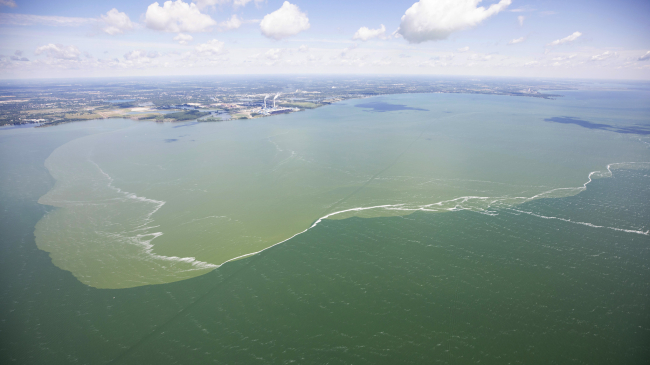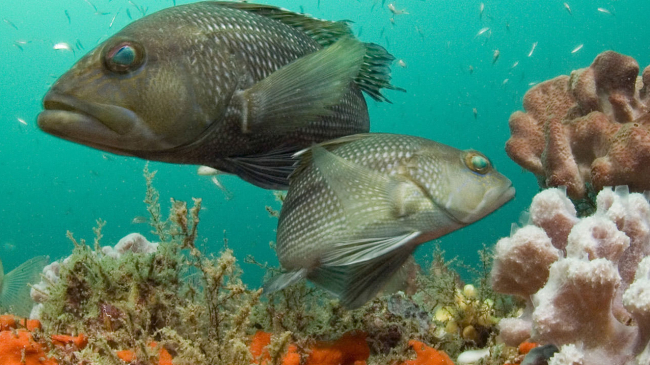NOAA has awarded more than $1.3 million to three universities for research on how economically and ecologically important marine species and coastal habitats are affected by ocean acidification.

NOAA researcher Ian Enochs dives over underwater vents near an uninhabited volcanic island north of Guam. Given its remoteness, the island offers a unique natural laboratory to study how ocean acidification affects coral reef ecosystems. (Image credit: NOAA)
Modeled pH in Surface Waters. (Credit: With permission from Feely, Doney and Cooley, Oceanography, 2009)
The research that comes from these awards will tell scientists how the chemistry of the coastal ocean is changing, where these changes will be most acute, and what the effects of those changes will be on marine animals and habitats. It will also help coastal communities plan for these changing conditions.
Ocean acidification — the increase in seawater acidity caused by increased carbon dioxide in the atmosphere — has the potential to fundamentally change the ocean, its habitats, food webs and marine life. It can affect commercially important species such as crabs, oysters, clams and mussels directly, or by its effects on habitat-building species such as corals and sea grasses.
“Climate change is affecting our nation’s coastal and ocean waters, and ocean acidification is a silent but critical product of that change that is rapidly affecting our food security, coastal economies, and culture,” said Russell Callender, Ph.D., acting assistant NOAA administrator for the National Ocean Service. “However, we’ve been limited by the lack of information on how ocean acidification and nutrient pollution interact. These grants, and the research they will produce, will help us close that gap.”
The damage caused by increasing ocean acidification coupled with eutrophication and hypoxia is predicted to be widespread in marine ecosystems. (Credit: NOAA Ocean Acidification Program)
While the primary cause of ocean acidification is increased carbon dioxide in the atmosphere, land-based sources of freshwater, carbon, and nutrients such as nitrogen-based fertilizers can play a part in coastal waters. For example, nutrients that fuel algae growth can result in added carbon dioxide.
“We need research to understand how and where the ocean chemistry is changing, and how it will affect commercial fisheries species and critical marine habitats,” said Libby Jewett, Ph.D., director of NOAA’s Ocean Acidification Program. “These new projects expand NOAA’s capacity and efforts to respond to this serious threat."
The funding will support three projects in California, Texas, and Maryland:
-
The University of California Los Angeles will lead a $420,000 project with collaborators from NOAA’s Pacific Marine Environmental Lab, the University of Washington and the Southern California Coastal Water Research Project to predict what areas of the California Current will be particularly vulnerable to low oxygen and ocean acidification.
-
Texas A&M University at Corpus Christi will receive $482,381 to understand how changes in water flow may cause hypoxia and short-term ocean acidification in Texas estuaries.
-
The University of Maryland Center for Environmental Sciences will lead a $435,992 project with Oregon State University and the University of Delaware to determine acidification conditions in Chesapeake Bay, and how they relate to ongoing oyster restoration efforts.
Coral reefs are a major concern in a world of increasing ocean acidification and nutrients. (Credit: NOAA Ocean Acidification Program)
These three projects are part of NOAA’s overall investment in understanding the emerging threat of ocean acidification. Congress recognized the importance of these issues by passing the Federal Ocean Acidification Research and Monitoring Act in 2009. This legislation outlined a coordinated process for federal agencies to create a plan for effective monitoring of processes and consequences of acidification on marine organisms and ecosystems. It also lead to the establishment of NOAA’s Ocean Acidification Program, a partnership among four NOAA offices.
Funding for these awards comes from a partnership between NOAA’s National Centers for Coastal Ocean Science and the Ocean Acidification Program.
The National Centers for Coastal Ocean Science delivers ecosystem science solutions for NOAA’s National Ocean Service and its partners, bringing research, scientific information and tools to help balance the nation’s ecological, social and economic goals. Visit our website for more about NCCOS research.
NOAA’s mission is to understand and predict changes in the Earth's environment, from the depths of the ocean to the surface of the sun, and to conserve and manage our coastal and marine resources. Join us on Facebook, Twitter, Instagram and our other social media channels.
Contact:
Ben Sherman
301-713-3066




